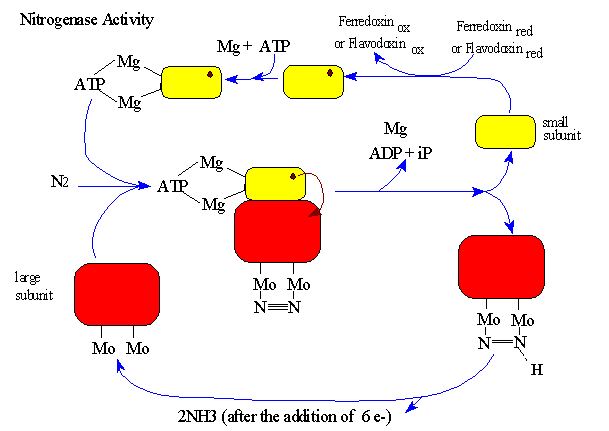
Nitrogen fixation involves the cleavage of the triple bond of N2 by the enzyme nitrogenase.
The ability to fix nitrogen depends on presence of nitrogenase. The only confirmed nitrogen fixers are bacteria (Eubacteria and Archaebacteria)
Nitrogenase activity decreases sharply
upon exposure to oxygen and methods have been devised for the
protection of nitrogenase. These are physical,
behavioral or biochemical such as high respiration rate, scavenging
of oxygen, production of leghaemoglobin.
Organism |
Strategies |
| Clostridium | Avoidance |
| Klebsiella pneumoniae | avoidance, respiratory consumption of O2 |
| Azospirillum | Migration away from O2 |
| Azobacter | Respiration, conformational protection |
| Photosynthetic bacteria | avoidance,some respiratory protection |
| Legume root nodules | respiration, leghaemoglobin |
| actinorhizal nodules | respiration, barrioer (vesicle) formation |
| Cyanobacteria- heterocystous strains | spatial separation (heterocysts), respiration |
| Cyanobacteria- non-herterocystous | temporal separation - clumping, respiration, nitrogenase |
Most well known is the Rhizobium-Legume association. Cyanobacteria will also form Symbiotic relationships:
N-Fixing Cyanobacterial -plant associations
| Plant division | Cyanobacteria forming symbiosis |
| Chrysophyta (Diatom) | Chaetoceros, Rhizosolenia |
| Anthocerophyta (mosses) | Anthoceros, Phaeoceros, Notothylas, Dendroceros |
| Hepaticophyta (liverworts) | Blasia, Cavicularia |
| Pteridophyta (ferns) | Azolla |
| Cycarophyta (cycads) | Bowenia, Ceratozamia, Cycas, Dioon, Encephalartos, Lepidozamia, Macrozamia, Microcycas, Strangeria, Zammia |
| Angiospermae | Gunnera |
![]() To the Life Sciences Interactive Educational Center
To the Life Sciences Interactive Educational Center
![]() To the Hebrew University of Jerusalem
To the Hebrew University of Jerusalem